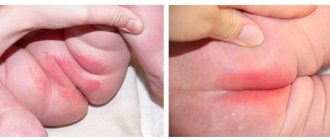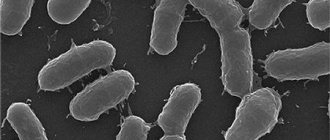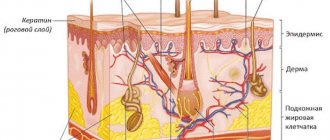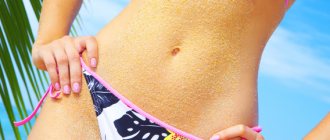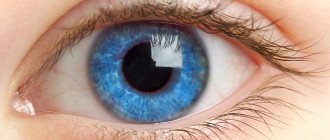The main thing in caring for a newborn boy is taking care of his skin. In infants, it is a sensitive organ that is both a way of interacting with the world and a protective barrier. The baby's skin is formed from cells of the same type as the nervous system, and therefore contains many receptors. Skin is a kind of mirror in which the well-being and health of the baby is reflected.
The skin also performs a respiratory function: 60% of all gas exchange occurs through it. Meanwhile, the thickness of the skin in a newborn baby is only 0.4 mm (in an adult - 2 mm), and the barrier stratum corneum is initially absent. That's why baby's skin is more susceptible to infections and various factors: water, heat, solar radiation, wind and, of course, detergents. It is not surprising that about 10% of doctors’ calls to children are related to skin diseases. Proper care of your baby's skin and careful selection of cosmetics will help you avoid many unnecessary problems.
Causes of diaper rash in newborns
In fact, the main causes of diaper rash in newborns depend on the parents themselves. So, when the child begins to be swaddled and put on a diaper, access to fresh air is blocked. The baby may overheat and sweat. As a consequence, this pathology develops. Therefore, parents need to take more careful care of their baby.
The main cause of inflammation is excess moisture. Toddlers “go to the toilet” quite often. The main cause of development may be diarrhea. Even with the most ideal diapers, it is difficult to avoid this phenomenon. No matter how well they absorb excess moisture, it still remains. When urine comes into contact with bacteria excreted from the baby's stool, ammonia is formed. This is a rather aggressive chemical substance, which can cause pathology. Even if you change diapers frequently, the risk of inflammation always remains.
Another reason for the development of the disease is friction or sensitivity to chemical compounds. So, this pathology can appear due to friction of the diaper on the skin, this is especially dangerous if the child has increased sensitivity to chemical compounds. A negative reaction may well be caused by fragrances that improve the smell of diapers or detergents. Even skin care products can cause a negative reaction.
New products often become the cause of the development of this pathology. The risk increases during the introduction of new complementary foods or simply other products. New food can change the composition of stool and influence intestinal function in a certain way. If a woman is breastfeeding, then the baby’s body is able to react to the foods that she consumes.
An infection can easily develop under a diaper. After all, a warm and humid environment is the best place for the growth of fungi and bacteria. Therefore, the child’s skin must be carefully monitored.
Symptoms of diaper rash in newborns
The main symptoms of diaper rash in newborns appear depending on the stage of the disease. So, there are three degrees of pathology.
The first stage is characterized by slight hyperemia of the skin. At the same time, its integrity is not violated.
The second stage, as a rule, manifests itself in the form of bright red eroded areas with multiple microcracks. Sometimes pustules and other rashes appear. At this stage, it is necessary to be wary and begin appropriate treatment.
The third stage is the most difficult. Pathological areas have pronounced hyperemia, weeping cracks and even detachment of the epidermis. At this stage, the baby can easily become infected with fungi or bacteria with the further development of microbial eczema. Inflammatory lesions in the second and third stages are accompanied by pain, itching, burning and significantly affect the baby’s well-being. He is constantly restless and cries. The child may suffer from fever, deterioration of sleep and appetite.
Diaper rash in newborn boys
As a rule, diaper rash in newborn boys is no different from that which occurs in girls. The places of their manifestation are the same. So, often areas of weeping appear in the groin area, in the axillary folds, on the legs, arms and neck.
When the first symptoms appear, treatment should be started immediately, regardless of what gender the patient is. After all, this pathology appears the same way. It is also possible to prevent the development of inflammation of the skin. To do this, it is necessary to carry out all preventive measures. Change diapers more often, treat the baby’s skin and let it “breathe” as much as possible.
Diaper rash in newborns can occur for various reasons. Even in cases where the child is carefully cared for. After all, changing foods changes the functioning of the intestines, new bacteria appear and therefore this pathology can develop. No matter how expensive and good diapers are, they cannot save you from inflammation of the skin.
Diaper rash in newborn girls
Diaper rash develops in newborn girls due to poor care. After all, many mothers, when purchasing super-class diapers, think that they can save them from many problems. In fact, everything is not like that. Even despite the high degree of absorption, moisture remains. This leads to the development of this disease. You need to change the diaper often. It's best to let your skin breathe and not wear it all the time.
It is also necessary to monitor the baby’s nutrition. Changing products also changes the condition of the stool. Thus, new bacteria appear, which, when reacting with urine, turn into ammonia. Chemical exposure to a baby’s skin is unacceptable. Therefore, it is still worth introducing complementary foods carefully. A young mother must also take care of her own health, because the food she eats also affects the child’s body.
It is important not to start the development of wet areas. At the first stage, the simplest hygiene procedures can help. In later stages it will be necessary to treat with serious medications.
Diaper rash in newborns in the groin
Diaper rash often appears in the groin of newborns, because this is the most common place for infection to spread. This area contains a large amount of fat deposits. It is because of them that the skin rubs against each other, resulting in areas of weeping.
If the damage is minor, then it will not require special treatment. Ointments or creams are not entirely suitable for a baby’s skin. Because they will not be able to breathe under their layer. It is necessary to make sure that the skin breathes. This is especially important after feeding and swaddling. In this case, baths of string and chamomile will help perfectly.
These herbs are great for rubbing reddened areas. To carry out this process you will have to use cotton swabs. After which it is recommended to apply a protective ointment, for example, zinc, to the skin. It can save the skin from irritation and friction. If the inflammation does not go away, then baths of a light pink solution of potassium permanganate come to the rescue. It is advisable to add a decoction of tannin or oak bark to them.
It is important to wash things with special children's products and be sure to rinse them. After bathing the baby, pat dry with a napkin or towel. And you shouldn’t forget about daily air baths.
Diaper rash on the butt of a newborn
Diaper rash occurs on the bottom of a newborn quite often. Because this is where a large accumulation of moisture is located. Constantly wearing a diaper leads to unpleasant phenomena.
To carry out high-quality prevention, it is worth paying more attention to the hygiene of the child. So, the diaper should be changed often, not every hour, but still. In addition, there is no need to hope that an expensive diaper can save you from all troubles. All the same, no matter what its degree of absorption, the moisture remains. In a warm and humid place, bacteria develop much faster and thereby lead to the development of this pathology.
It is always necessary to monitor the condition of the child’s skin. It is necessary to make special baths from chamomile decoction. In more serious cases, resort to the help of potassium permanganate. There are many methods to get rid of diaper rash in newborns. The most basic of them is the ability to obtain air. Therefore, there is no need to wear a diaper all the time.
Diaper rash on the neck of newborns
Weeping areas on the neck are not so common. The main place of development has always been the groin area. After all, it is there that there is a constant accumulation of moisture due to wearing a diaper.
Why do they appear on the neck? In fact, everything is very simple. Larger babies are susceptible to this phenomenon. The fact is that there are quite a lot of folds on the child’s body, and it is in them that areas of weeping are formed. Friction of the skin against each other leads to this phenomenon. Moreover, if the treatment process is not started in time, the condition may worsen. As a rule, cracks and even purulent inflammations appear.
There is no need to worry; it is important to start eliminating redness of the skin in time. First of all, you need to include baths using chamomile decoction in your daily hygiene procedures. A weak solution of potassium permanganate will also cope perfectly with the problem of redness. In addition, the baby’s skin should always be wiped and baby cream should be used in places where inflammation may occur.
Diaper rash under the arms of a newborn
Why do areas of weeping appear under the armpits of a newborn and how to deal with this phenomenon? In fact, they can appear at any time. Sometimes even compliance with all preventive measures cannot protect the baby from the harmful effects of redness of the skin.
Under the arms, this phenomenon occurs due to the constant friction of the skin against each other. As you know, the most common places for the development of this pathology are skin folds. What to do in this case? It is necessary to carry out a number of preventive measures. It is advisable to include baths with a weak solution of potassium permanganate in hygiene procedures. Chamomile infusions should not be ignored either. Areas that are prone to redness need to be treated in a special way.
In addition, if diaper rash does occur in newborns, you should try to remove it using more gentle methods. If you have severe redness, you cannot do without consulting a doctor and using medications.
Weeping diaper rash in newborns
Weeping diaper rash occurs in newborns at more severe stages. In this case, it is necessary to use only medications. It’s just worth noting that they should be non-greasy. Under no circumstances should you treat weeping inflammations with oils or ointments. They cover the damaged area with a film and prevent healing.
For several days, lotions should be applied to wet surfaces. They need to be made from a 1-2% tannin solution, 0.25% silver nitrate solution and 0.1% rivanol solution. Only the attending physician can prescribe these medications! You cannot resort to such therapy on your own!
After the weeping disappears, zinc paste is applied. An emulsion with bactericidal substances has also proven itself well. It is important that the baby receives adequate nutrition during treatment. Under no circumstances should you do anything yourself.
Severe diaper rash in newborns
What are the dangers of severe diaper rash in newborns, and why does it occur? The fact is that in the later stages they are difficult to treat. You need to think about this problem at the moment when inflammation appears. The third stage is the most difficult in itself.
Purulent inflammation occurs on the skin, and detachment of the epidermis is observed. All this is very serious and under no circumstances should the development of a severe stage be allowed. Timely prevention and elimination of the problem at the initial stages will save the situation.
In the final stages, weeping wounds may appear. In this case, it is necessary to resort to the help of medications. These should be non-greasy products. The fact is that ointments and oils cover the inflammation with a special film, which slows down the entire healing process. Under no circumstances should you start treatment on your own. Here everything is done under the supervision of the attending physician.
Caring for a newborn boy: bathing
Caring for a newborn up to six months of age involves daily bathing. In the future, you can bathe the baby every other day or even two. Bathing is intended, first of all, not to cleanse dirt (a baby who cannot walk or crawl does not get particularly dirty yet), but to wash away the waste products of the sebaceous and sweat glands from the skin and give it the opportunity to breathe fully.
At the beginning of life, a newborn has a neutral skin pH and is therefore very vulnerable to bacteria and external influences. Only by six months the environment becomes more acidic and a protective glycolipid mantle forms on the skin. It should be protected from excessive use of detergents and maintained by lubricating the skin with natural oils. Olive, almond and other natural oils have a composition similar to that of sebum, so they easily penetrate deep into the skin and saturate it with beneficial substances that increase its protection. After each bath, you can carefully lubricate all the folds of the newborn’s skin with a thin layer of sterile hygienic oil, baby cream or milk. Close attention should be paid to the area behind the ears, where the delicate skin often gets wet and crusts form. After six months, you can moisturize your baby’s skin as needed.
Herbal medicine - the use of herbal decoctions - is at your discretion, just do not forget the fact that recently more and more babies are born with a predisposition to allergies.
| This is important to know! For diaper rash, especially associated with erosion, the skin should not be treated with oils, creams and alcohol-containing solutions. It is necessary to consult a pediatrician, he will select special disinfectants and drying agents. You can return to moisturizing your skin when your skin stops getting wet. You should also know that diaper rash in the perineal area is not necessarily a consequence of improper care. This may be the first symptom of atopic dermatitis. Consult a pediatrician or pediatric dermatologist (for an appointment call: +7 (495) 229–44–10, +7 (495) 954–00–46). |
Diagnosis of diaper rash in newborns
Diagnosis is usually made based on a visual examination of the skin. There is no point in carrying out any tests or procedures. After all, all the redness is visible.
The examination is carried out by a pediatrician or dermatologist. In some cases, microscopic examinations are performed. As a rule, they include skin scraping for fungi and bacteriological culture. This procedure is carried out only in more serious situations.
Sometimes wetting occurs due to allergic reactions of the body. In this case, an examination is carried out by a pediatric allergist. Naturally, it is necessary to determine what contributed to the development of such a reaction.
In any case, you shouldn’t deal with wet areas on your own. It is better to see your doctor once again to determine the nature of the development of the disease. In this way, its reoccurrence can be prevented.
Treatment of diaper rash in newborns
Only minor redness can be removed with fresh air and hygiene; in other cases, comprehensive treatment of diaper rash in newborns is necessary. Naturally, in the early stages you can resort to the help of chamomile decoctions and a weak solution of potassium permanganate.
After each washing and drying, it is recommended to use Desitin cream. This is a very good product, although it has a very unpleasant odor. All due to the fact that the composition includes cod liver oil. Despite this, the ointment perfectly protects the baby’s skin during sleep.
Let's also consider Bepanten cream. It also promotes rapid healing of wounds. You can use talc or starch. Only in this case a side effect occurs. The products can clump in the area of inflammation and thereby rub them even more. Therefore, it is best to use special ointments.
The main thing is not to start treatment on your own. It is worth consulting your doctor. It is important to start the healing process on time. The integrated use of baths, decoctions and liniments will help perfectly in this matter.
How to treat diaper rash in a newborn?
In this case, everything depends on the stage of development of inflammation. So, in the first stages, the best way to get rid of inflammation is fresh air.
If possible, you should always keep your baby “half naked.” That is, don’t wear diapers so often, especially if the child is at home. Dry skin that is exposed to air will heal faster.
When the baby is sleeping, you should try to remove his diaper. It is better to put a diaper or oilcloth on it. If the baby is used to diapers, and it is more convenient for parents, it is worth changing it as often as possible. Even at night! You should definitely try diapers from different manufacturers. After all, sometimes the skin reacts differently to them.
You should use protective creams that create a so-called barrier. Zinc ointment can produce a waterproof layer on the skin. This will protect your baby from excess moisture.
You should constantly wash your child with warm water and wipe him dry. If this is not possible, then you should wipe the baby with a damp cloth. You should not use disposable wipes or other means, they can worsen the situation.
Causes of peeling
We have identified three main external factors that can cause a newborn to have severely flaky skin on the body and face.
- Dry air
. Too dry indoor air can not only cause peeling of the skin on a newborn’s body, but also cause constant thirst and increased secretion of mucus from the nasal passages. Dry skin in a newborn after birth is more susceptible to damage and pathogens.
What to do?
The air humidity in the room where the newborn is constantly located should be 55–70%. You can correct the situation by using a humidifier. If you don’t currently have a humidifier, you can place containers of water in the room, spray water from a spray bottle, and hang wet diapers. The main thing is to maintain adequate hydration. Air humidity is measured with a hygrometer. They are built into many humidifier models.
- Improper care
. Caring parents often begin to bathe their newborns in herbal infusions, a solution of potassium permanganate, or use soap with each bath. All these products dry out baby's skin, making it more vulnerable, including peeling, after which the baby's skin peels off.
What to do?
An infant should be bathed in boiled water, without adding herbal decoctions, infusions, potassium permanganate, or aromatic additives. Baby soap can be used no more than once a week. Be sure to pay attention to the skin reaction after such a bath. Later, when the child’s body adapts to external factors, decoctions of medicinal herbs can be added, provided that the child does not have an allergic reaction.
- Weather
. Wind, sun, rain - all this can cause peeling after a walk. If peeling occurs on the face, it is most likely a reaction to the weather.
What to do?
Provide protection from wind and sun while walking - a stroller with a deep canopy, a sun cape, rain film, closed clothing for the season - all this will help to avoid unwanted external influences during the baby’s adaptation period. If your newborn has peeling skin on his body, you can lubricate the exposed areas of the body with peach or olive oil before a walk. You need to go outside after the oil has been absorbed into the skin.
How to treat diaper rash in newborns?
First of all, it is worth noting that under no circumstances should you use disposable napkins and other tricks. At this stage, comprehensive treatment should be carried out.
So, even the most ordinary creams and liniments are perfect. It is important that they are not greasy. In this case, a film may form on the pathological area, which complicates the healing process.
Lotions should be made, preferably made from a 1-2% tannin solution. You can wipe the child with a damp cloth, which has previously been soaked in chamomile decoction. It is important to pat your baby dry after any bathing or drying procedure!
In general, it is better to use complex treatment. So, it is advisable to bathe the baby in a weak solution of potassium permanganate and chamomile. Naturally, the result should be secured with special creams and ointments. But under no circumstances should they be used without the knowledge of a doctor.
Bepanten
Bepanthen is an excellent preventative and therapeutic agent. It is used both to prevent inflammation and to treat chafed and irritated skin. In addition, it effectively fights inflammation, abrasions and diaper dermatitis. Therefore, its spectrum of action is quite wide.
The main active ingredient of the drug is provitamin B5. It is able to accelerate mitosis, as well as regulate cellular metabolic processes and increase the strength of collagen fibers.
The cream is quickly absorbed and thereby contributes to the effective replenishment of endogenous pantothenic acid reserves. Bepanten has excellent moisturizing and regenerating properties. The cream is highly safe and has no side effects. That is why it is recommended for children to use it.
The product must be applied after every diaper change. This is naturally done on cleansed and dry skin.
Baneocin
Baneocin is used only in severe stages. Because this powder fights complex inflammatory processes.
Baneocin is not only effective, but also affordable compared to other ointments and creams. The powder can be used to treat wounds and is done painlessly. For a small child this is very important, because he already experiences unpleasant sensations.
It is worth noting that this product is supplied both in the form of liniments and powder. Baneocin has a good anti-inflammatory effect. The powder can be applied to the treated wound and no discomfort will be observed. If the condition of weeping is satisfactory, then one use of the product will be enough. When the process is difficult, you need to apply the powder after each swaddling.
If we talk about the ointment, it has the same properties. Apply it after each diaper change to clean, cleansed skin.
Fukortsin
An excellent antifungal and antiseptic drug is fucorcin. This solution is for external use only. It is actively used to treat abrasions, scratches, as well as cracks and erosions of the skin.
Fucorcin should only be applied with a cotton swab or swab. The affected areas are wiped 2-5 times a day. To enhance the effect of the drug, the treated area should be soaked in cream for newborns after drying.
The medicine is really good, there is no need to doubt its effectiveness. It should be noted that it does not require application after every diaper change. To notice a positive effect, 2-5 times of application to the skin is enough.
Some doctors recommend using the drug for this pathology of candidal origin. But this must be done with extreme caution. In general, fucorcin is an excellent solution for combating major skin problems.
How to lubricate diaper rash in newborns?
Not many people know what to lubricate the affected skin of a child in order to achieve a good effect. So, special creams and liniments come to the rescue. It is important that they are not greasy.
The fact is that fatty ointments can leave a film on top of the wet areas. This impairs the healing process. Therefore, you should not use any means yourself. There is always a risk of making the situation worse.
Thus, cindol, bepanten and desitin are considered good ointments. All of them are designed to combat various inflammations of the skin. Thanks to their gentle composition, they can also be used by children.
A good method of getting rid of this pathology is to use sunflower oil, which will be heated in a water bath. This is a good folk recipe. But it still requires the approval of the attending physician.
Oils
What oil should be used to achieve a good effect?
One of the best remedies in this matter is sea buckthorn oil. You can buy it at any pharmacy. To get rid of redness of the skin and remove the pathological process, you need to apply oil after each diaper change. If the affected area is on the arms, legs or neck, then you should apply a napkin generously moistened with oil to this area. Redness and irritation will begin to gradually go away the next day.
Regular sunflower oil also helps cope with this pathology perfectly. But before using it, it is advisable to boil it in a water bath. Application methods are similar. Every time after changing a diaper, the skin should be wiped with oil. If the inflammation is located in other places, then a napkin soaked in oil is applied to the affected area.
Vaseline and olive oil also have similar effects. It is important to constantly repeat the procedure, but not to overdo it.
Ointments
Specialized liniments can also have a positive effect. Today there are quite a lot of ointments to combat skin inflammation. This allows you to choose a truly high-quality and effective drug.
So, zinc ointment is good. It is important to know how to use it correctly. The product is applied to the baby’s cleansed and dry skin in a thin layer. This procedure must be repeated every time you change a diaper or change a diaper. Zinc ointment is also used to prevent the development of weeping areas. It should be used in the same way, but no more than 3-5 times a day. The medicine will help relieve discomfort in the form of itching and burning.
Tsindol ointment also has a good effect. But it must be applied in a special way. So first it is recommended to bathe the baby in a weak solution of potassium permanganate. Then dry the child and treat the inflamed areas with liniment. It is important to shake it before use and leave the baby naked after application so that it is completely absorbed into the skin. During the day, the procedure is carried out as necessary. So, if the baby sweats or the diapers are wet, everything repeats.
Today there are a huge number of different ointments. But all of them can be used only after the approval of the attending physician.
Crema
Creams have also proven themselves well in the treatment of this pathological condition. Thus, desitin is one of the best in its field. This is a wonderful tool in the fight against this pathology.
This cream can be called universal. Because it can have a positive effect on both adults and children. The affected area must be thoroughly rinsed with warm water and left open for a while. You need to let the skin dry on its own. After which the cream itself is applied in a thin layer and left in the air again. Only after the liniment has been absorbed can the child be dressed.
The baby's gentle nature cream is quite good. It was developed specifically for newborn skin care. It contains exclusively natural ingredients that do not injure the skin and promote their rapid healing. The cream should be applied every time you change a diaper and even at night.
Caring for a newborn: intimate hygiene
Almost every mother of a newborn boy has three main questions:
- To wash or not to wash your baby after every diaper change?
- Should I open the foreskin of the glans penis while washing?
- Is it harmful for a child to wear diapers?
Let's answer them in order:
To wash or not to wash – that is the question
Caring for a newborn boy necessarily includes washing. Boys should be washed no less often than girls! That is, every 2-3 hours or with every diaper change. Unlike girls, boys can be washed in any direction, even from front to back, even vice versa, you can’t just do it in the pelvis (after defecation). Residues of enzymes and undigested food can cause infection of the genitourinary organs and irritation of the perineum, leading to diaper rash. Therefore, you only need to wash the boy with running water. And after washing, do not rush to put on a diaper and dry the skin properly. The more air baths your baby takes, the better for his skin! It is not recommended to use soap, solutions of soda and potassium permanganate and other detergents when washing, so as not to deprive the baby’s skin of the protective glycolipid mantle. After washing, inguinal folds and irritated areas can be lubricated with hygienic oil - olive, almond (sold at the pharmacy). The scrotum and penis do not need to be lubricated.
| This is important to know! If the appearance of the penis makes you wary: for example, it is red, swollen, or inflates when urinating, contact a pediatric urologist immediately. |
Failure to comply with the rules of intimate hygiene in a newborn boy can lead to balanoposthitis (inflammation of the glans penis) and a stage of phimosis (growth of the foreskin), which can only be corrected surgically. Inflammation of the genital organs suffered by a boy in childhood can result in infertility, impotence, prostatitis and other unpleasant problems in adulthood. Proper care of a newborn boy is the key to his good male health in the future.
Foreskin: to open or not to open the head of the penis?
Modern, progressive doctors strongly recommend leaving the foreskin of boys until they are 5–6 years old alone. At an earlier age, the inner surface of the foreskin is still firmly connected to the head of the penis. This phenomenon is absolutely normal; in medical language it is called physiological phimosis. Premature shifting of the baby's foreskin leads to the formation of small wounds, which, when healing, leave scars, which leads to an even greater narrowing of the foreskin.
| This is important to know! If your baby has been circumcised, the penis will be red and produce a yellowish secretion for the first week. Make sure that the redness gradually disappears and that a weeping yellow crust does not form on the head of the penis. If this happens, contact a pediatric urologist immediately. |
Diapers: yes or no?
There is an opinion that constantly wearing diapers overheats the baby’s genitals, disrupting their natural formation and the process of sperm production. Studies were conducted at the Scientific Center for Children's Health, which showed that an increase in temperature by 2 ºС due to the use of diapers does not affect sexual function and the formation of the genital organs. This is also supported by the fact that a generation of children has already matured who grew up in diapers, but at the same time successfully have their own babies (although the percentage of primary male infertility has definitely increased these days, no matter what causes it). But experienced experts still recommend not keeping your baby in diapers all the time.
Sometimes a baby becomes allergic to a diaper, or rather, not to the diaper itself, but to the materials from which it is made. This doesn't mean you need to give up diapers altogether. Just change the manufacturer and always make sure that the diaper matches the baby's weight. For allergies in newborns, it is very good to use “natural baby swaddling systems.” At the first stage of their use, they require a little more time to learn than regular disposable diapers, but later, once you get used to them, you will appreciate that, firstly, they are more environmentally friendly, and secondly, in the end they are cheaper to use than disposable ones.



